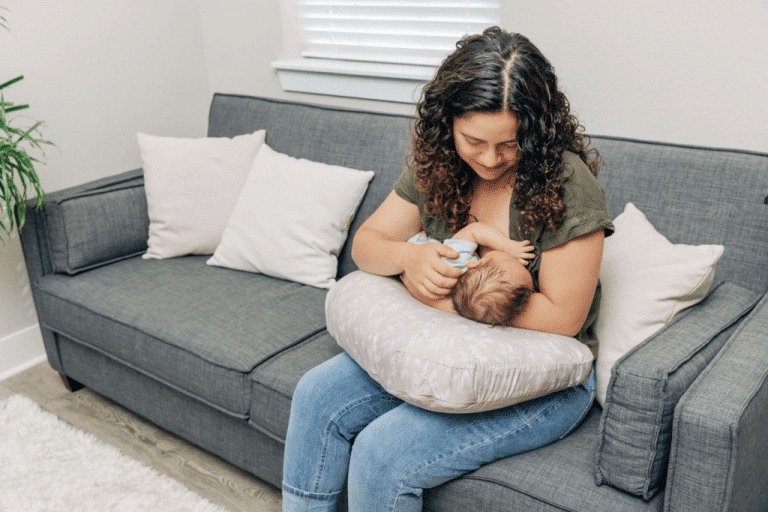Hey there, tired parent! Does this sound familiar?
You finally get your baby to sleep, tiptoe away, grab a cup of coffee, and then—boom—exactly 45 minutes later, the crying starts. Welcome to the world of the “45-minute intruder”!
This sneaky sleep thief affects nearly all babies at some point. Your little one isn’t trying to drive you crazy (promise!).
They’re just struggling with something their developing brain isn’t quite ready to handle yet.
I’ve been there, too, watching the clock and thinking, “Please, just 10 more minutes…”
The good news? It’s temporary! Let’s chat about why this happens, when it ends, and how to survive until then.
What is the 45-Minute Intruder?
The 45-minute intruder is a term used to describe a common sleep pattern where babies consistently wake up around 45 minutes after falling asleep, particularly during daytime naps.
This isn’t a medical condition but rather a normal developmental phase related to how infant sleep cycles work.
Unlike adults who complete a full sleep cycle in about 90-120 minutes, a baby’s first sleep cycle typically lasts around 45 minutes.
You’ll know your baby is experiencing the 45-minute intruder if:
- They consistently wake up crying or fussing at the 45-minute mark
- They show signs of still being tired after waking (rubbing eyes, yawning)
- They struggle to fall back asleep without assistance
- Naps are consistently short regardless of how well they fall asleep initially
Why Do Babies Wake After 45 Minutes?
Babies have short sleep cycles. Their cycles last about 30-45 minutes. Adults have longer cycles of 90-120 minutes. At the end of each cycle, babies enter lighter sleep. During this light sleep, they can easily wake up.
Several things can cause these short naps:
Sleep Regression
Babies experience sleep regressions at certain ages, such as around 4 months, 8-10 months, and 12 months.
During these times, their brains are developing quickly, which can disrupt sleep. Your once-good napper might start waking up after just one sleep cycle. It’s normal but tough for tired parents.
It’s Time to Drop Naps
As babies grow, they need fewer naps. Short naps might mean it’s time for a schedule change.
For example, an 8-month-old taking three short naps might be ready for two longer ones. Watch for signs like fussiness before naps or trouble falling asleep. These can show it’s time to change the nap schedule.
Overtiredness
A very tired baby actually sleeps worse. When babies stay awake too long, their bodies produce stress hormones, which make it hard for them to fall asleep.
A baby who has been awake too long will likely wake up after just 45 minutes. This creates a cycle of short naps and growing tiredness.
Hunger
Young babies have tiny stomachs. After one sleep cycle, they might truly need to eat again. This is common for babies under 6 months. It also happens during growth spurts.
If your baby wakes hungry rather than just fussy, this could be why. As they grow and start solid foods, many babies naturally take longer naps.
Developmental Changes
Babies learn new skills quickly in the first year. Each new skill—rolling, sitting, crawling—affects sleep. Babies process these new skills during sleep, which can wake them up between cycles.
They might also be excited to practice their new skills rather than sleep more. As they become more aware of the world, they notice more things that can wake them up.
The good news? This phase won’t last forever.
Regular routines, proper wake windows, and a good sleep space help support your baby through this stage.
How to Prevent 45-Minute Naps?
While you can’t force your baby to outgrow the 45-minute intruder before they’re developmentally ready, you can try several strategies to help them take longer naps.
Build Self-Soothing Skills
Your baby needs to learn how to fall back asleep on their own between sleep cycles. Here’s how you can help:
- Give your baby a comfort object if they’re over 12 months old.
- Try putting your baby down drowsy but still awake.
- If it fits with your parenting style, give your baby a few minutes to resettle before you step in.
- Use the same calming activities before each nap to signal sleep time.
Adjust Wake Windows
Getting the timing right makes a big difference. Put your baby down too early or too late, and short naps are more likely.
Watch your baby for sleep cues like rubbing eyes, pulling ears, or becoming less active.
| Age Range | Recommended Wake Window |
|---|---|
| 0-3 months | 60-90 minutes |
| 3-5 months | 90-120 minutes |
| 5-7 months | 2-3 hours |
| 7-12 months | 3-4 hours |
Note: Wake windows refer to the amount of time a baby should be awake between naps or before bedtime.
Create a Sleep-Friendly Space
Your baby’s sleep environment can make or break nap time.
Make the room dark with blackout curtains for daytime naps. Keep the temperature comfortable—around 68-72°F works well for most babies. Use white noise to block out household sounds. Dress your baby in comfy clothes that aren’t too hot or cold.
Try the “Rescue Nap” Method
When your baby wakes after 45 minutes, try to extend the nap.
Go to your baby quickly when they wake and use your usual soothing methods. Some babies will fall back asleep with help. Even if they don’t, keeping them in a dark, quiet room for 10-15 minutes teaches them that sleep time isn’t over yet.
Adjust Feeding Times
Hunger can wake a baby at the wrong time.
For younger babies, try dream feeds or slightly different feeding times so hunger doesn’t hit during sleep transitions. Make sure your baby gets full feeds during the day to prevent hunger wakings during naps.
Remember, every baby is different. What works for one might not work for another. Be patient and consistent as you help your little one learn to take longer naps.
When & Why Do Babies Naturally Outgrow It?
Most babies start to outgrow the 45-minute intruder between 3 and 6 months old, but every baby follows its own timeline.
By 6 months, about 60-70% of babies can better connect sleep cycles. Some babies might still take short naps until they’re 8-9 months old.
Several important changes help babies sleep longer:
Brain Development: As your baby’s brain matures, their sleep cycles get longer. They gradually develop sleep patterns more like adults.
Better Internal Clock: Around 3-4 months, babies start making more melatonin. This hormone helps regulate sleep. Their bodies begin to understand day and night better.
Self-Soothing Skills: Between 4-6 months, many babies learn to calm themselves. This helps them fall back asleep during light sleep transitions.
What Affects The Timeline
Not all babies outgrow short naps at the same time. These factors can make a difference:
- Your baby’s unique personality and development pace
- How consistent their sleep environment is
- Their feeding schedule and whether they’re getting full feeds
- How do you respond when they wake up
- Health issues like reflux or allergies that might disturb sleep
Remember that developmental timelines vary widely. Some babies naturally learn to connect sleep cycles early, while others take their time with this skill. Try not to compare your baby to others—they’ll get there when they’re ready.
Common Mistakes Parents Make
When dealing with short naps, parents often make a few common mistakes that can actually make the problem worse. Here’s what to watch out for:
1. Rescuing too quickly: If you rush in at the first sound, your baby doesn’t get a chance to practice falling back asleep. Give them a few minutes to see if they can resettle on their own.
2. Inconsistent routines: Babies thrive on predictability. If nap times change daily or the pre-nap routine varies, your baby can’t develop strong sleep associations.
3. Ignoring wake windows: Putting your baby down too early or too late can lead to short naps. An overtired baby has a harder time connecting sleep cycles.
4. Creating sleep props: If your baby always falls asleep while being rocked, nursed, or held, they may need those same conditions to fall back asleep between cycles.
5. Bright sleep environment: Many parents underestimate how light can disrupt sleep. Even small amounts of light can make it harder for babies to transition between sleep cycles.
6. Misinterpreting fussing: Sometimes, babies make noise or fuss briefly between sleep cycles without being fully awake. Rushing in might actually wake a baby who would have drifted back to sleep.
Small adjustments to your approach can make a big difference in helping your little one take longer, more restorative naps.
When to See a Pediatrician
While the 45-minute intruder is usually a normal developmental phase, sometimes persistent sleep difficulties warrant professional advice. Consider consulting your pediatrician or a pediatric sleep specialist if:
- Your baby is consistently taking only 45-minute naps beyond 8-9 months of age
- Unusual symptoms like excessive crying, apparent discomfort, or changes in feeding accompany sleep disruptions
- Your baby seems chronically tired despite your best efforts to support sleep
- You notice signs of sleep apnea (pauses in breathing, loud snoring, excessive sweating during sleep)
- You’re feeling overwhelmed or your mental health is suffering due to sleep deprivation.
A healthcare provider can rule out potential medical causes, such as reflux, allergies, or ear infections, that might be contributing to sleep difficulties.
Final Thoughts
Look, I won’t sugarcoat it—the 45-minute nap phase is tough!
But remember, you’re not doing anything wrong, and neither is your baby. This is just a pit stop on your parenting road trip.
Most babies wave goodbye to the 45-minute intruder between 3-6 months. Until then, try those sleep environment tweaks, watch those wake windows, and yes, occasionally cry into your cold coffee—we’ve all been there!
Be kind to yourself. Some days you’ll nail it, other days you’ll wonder if sleep will ever return to your home. It will!
One morning you’ll realize your baby slept for two hours straight, and you didn’t know what to do with yourself.
That day is coming sooner than you think!














